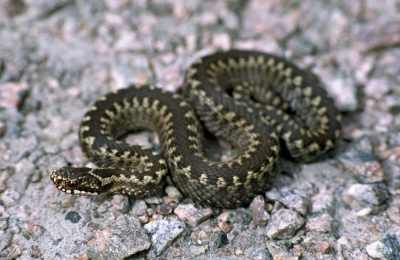
Vipers are a large family of snakes; the scientific name is Viperidae. They are found all over the world, with the exceptions of Antarctica, Australia, New Zealand, Madagascar, north of the Arctic Circle and island clusters such as Hawaii.
The family Viperidae includes adders, pit vipers (like rattlesnakes, cottonmouths and copperheads), the Gaboon viper, green vipers and horned vipers.
All vipers are venomous and have long, hinged fangs. “Generally more venomous vipers are in tropical areas, particularly South America and Africa,” said Alan Savitzky, a professor of biological sciences at Utah State University specializing in the biology of snakes. Vipers found in colder, northern climates, such as the black or European adder have more moderate venom.
Vipers range widely in size, though are generally stocky with short tails. One of the world’s smallest vipers is the Mao-Lan pit viper (Protobothrops maolanensis), which was discovered in China in 2011. They are less than 2 feet (61 centimeters) long, according to National Geographic. The longest viper — and the longest venomous snake in the Americas — is the South American Bushmaster (Lachesis muta), which grows to more than 11 feet (335 cm), according to the University of Michigan’s Animal Diversity Web (ADW).
Almost all vipers have a distinctive triangular head, according to Discover magazine. This head shape is due to the placement of their large venom glands in the mouth. Some nonvenomous species have evolved a similarly shaped head in order to potentially trick predators into thinking they are vipers. Additionally, most vipers have keeled scales, vertically elliptical pupils and coloring and patterns that serve as camouflage.
Vipers are known for their extreme fangs, which are long, hollow, hinged and rotatable, according to an article in the journal Physiological and Biochemical Zoology. These fangs connect to venom glands located behind the eyes at the back upper part of the jaw. Venom travels down through the follow teeth to be injected into prey as the viper bites.
Vipers can rotate their fangs together or independently, which allows them to wait until the last second to erect their fangs. Their mouths can open nearly 180 degrees so the ability to rotate their fangs within that space is an advantage. When not in use, vipers’ hinged fangs fold up and lie against the roof of the snake’s mouth. This allows their fangs to grow relatively long, according to Andrew Solway, author of “Deadly Snakes” (Heinemann-Raintree, 2005).
Vipers can extend their fangs and bite without injecting venom. This is known as a dry bite and is common in human snakebites. Dry bites enable vipers to conserve their previous venom, which can run out and takes a while to replenish, according to an article in the journal Tropical and Geographical Medicine.
Credit : Live Science
Picture Credit : Google




